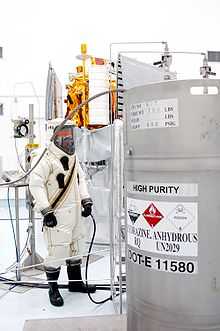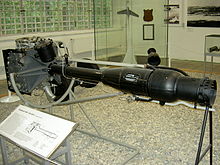Hypergolic propellant

A hypergolic propellant is a rocket propellant combination used in a rocket engine, whose components spontaneously ignite when they come into contact with each other.
The two propellant components usually consist of a
In contemporary usage, the terms "hypergol" and "hypergolic propellant" usually mean the most common such propellant combination: dinitrogen tetroxide plus hydrazine.[1]
History
In 1935,
Hypergolic propellants were discovered independently, for the second time, in the U.S. by

In Germany from the mid-1930s through
The only rocket-powered fighter ever deployed was the
The earliest
The
The trend among western space launch agencies is away from large hypergolic rocket engines and toward hydrogen/oxygen engines with higher performance. Ariane 1 through 4, with their hypergolic first and second stages (and optional hypergolic boosters on the Ariane 3 and 4) have been retired and replaced with the Ariane 5, which uses a first stage fueled by liquid hydrogen and liquid oxygen. The Titan II, III and IV, with their hypergolic first and second stages, have also been retired. Hypergolic propellants are still widely used in upper stages when multiple burn-coast periods are required, and in launch escape systems.
Characteristics

Advantages
Hypergolically-fueled rocket engines are usually simple and reliable because they need no ignition system. Although larger hypergolic engines in some launch vehicles use
As hypergolic rockets do not need an ignition system, they can fire any number of times by simply opening and closing the propellant valves until the propellants are exhausted and are therefore uniquely suited for spacecraft maneuvering and well suited, though not uniquely so, as upper stages of such space launchers as the
The most common hypergolic fuels,
Another advantage of hypergolic propellants is their high density compared to cryogenic propellants.
Disadvantages
Relative to their mass, traditional hypergolic propellants possess a lower calorific value than cryogenic propellant combinations like LH2 / LOX or LCH4 / LOX.[10] A launch vehicle that uses hypergolic propellant must therefore carry a greater mass of fuel than one that uses these cryogenic fuels.
The
Hypergolic combinations
Common
Common hypergolic propellant combinations include:[14]
- Titan II; all engines in the Apollo Lunar Module. Aerozine 50 is a mixture of 50% UDMH and 50% straight hydrazine (N2H4).[2]: 45
- Draco thrusters used by the SpaceX Dragon spacecraft.[18]
- SpaceX Merlin Engine Family and Rocketdyne F-1.
- ISRO rockets using Vikas engine.[19]
Less common or obsolete
Less-common or obsolete hypergolic propellants include:
- Aniline + nitric acid (unstable, explosive), used in the WAC Corporal[20]
- Aniline + hydrogen peroxide (dust-sensitive, explosive)
- Furfuryl alcohol + IRFNA (or red fuming nitric acid) – Copenhagen Suborbitals SPECTRA Engine[21][2]: 27
- Furfuryl alcohol + WFNA (or white fuming nitric acid)[2]: 27
- Hydrazine + nitric acid (toxic but stable), abandoned due to lack of reliable ignition. No engine with this combination ever went into mass production.[22]
- Gamma, with the peroxide first decomposed by a catalyst. Cold hydrogen peroxide and kerosene are not hypergolic, but concentrated hydrogen peroxide (referred to as high-test peroxide or HTP) run over a catalyst produces free oxygen and steam at over 700 °C (1,300 °F) which is hypergolic with kerosene.[23]
- Tonka (TG-02, approx. 50% triethylamine and 50% xylidine) typically oxidized with nitric acid or its anhydrous nitric oxide derivatives (AK-2x group in the Soviet Union) e.g. AK-20F (80% HNO3 and 20% N2O4 with inhibitor).[2]: 14–15, 116
- Messerschmitt Me 163 World War II German rocket fighter aircraft, for its Walter 109-509A engine.[2]: 13
- Turpentine + IRFNA (flown in French Diamant A first-stage)[24]
- UDMH + IRFNA – MGM-52 Lance missile system,[25] Agena and Able Upper Stages, Isayev-built maneuvering engines.[26]
Proposed, remain unflown
- Chlorine trifluoride (ClF3) + all known fuels – Briefly considered as an oxidizer given its high hypergolicity with all standard fuels, but ultimately abandoned in the 70s due to the difficulty of handling the substance safely. Chlorine trifluoride is known to burn concrete and gravel.[2]: 74 Chlorine pentafluoride (ClF5) presents the same hazards, but offers higher specific impulse than ClF3.
- Tetramethylethylenediamine + IRFNA – A sightly less toxic alternative to Hydrazine and its derivatives.
Related technology
rockets.Notes
- ^ "-ergol", Oxford English Dictionary
References
- Citations
- OSTI 767866.
- ^ ISBN 978-0-8135-0725-5. Archived(PDF) from the original on 10 July 2022.
- ^ Lutz, O. (1957). "BMW Developments". In Benecke, T. H.; Quick, A.W.; Schulz, W. (eds.). History of German Guided Missiles Development (Guided Missiles Seminar. 1956. Munich). Advisory Group for Aerospace Research and Development-AG-20. Appelhans. p. 420.
- ISBN 978-1-56347-649-5.
- ISBN 9783828902947
- ISBN 978-1-59420-227-8.
- ^ "SpaceX". SpaceX. Retrieved 2021-12-29.
- ^ "Fuel Propellants - Storable, and Hypergolic vs. Ignitable by Mike Schooley". Archived from the original on 24 July 2021.
- ^ "PROPERTIES OF ROCKET PROPELLANTS". braeunig.us. Archived from the original on 26 May 2022.
- doi:10.18434/T4D303.
- ^ A Summary of NASA and USAF Hypergolic Propellant Related Spills and Fires at the Internet Archive
- YouTube
- ^ The Nedelin Catastrophe, Part 1, 28 October 2014, archived from the original on 15 November 2014
- ^ "ROCKET PROPELLANTS". braeunig.us.
- ^ Apollo 11 Mission Report - Performance of the Command and Service Module Reaction Control System (PDF). NASA - Lyndon B. Johnson Space Center. December 1971. pp. 4, 8. Archived from the original (PDF) on 12 July 2022.
- ISBN 1-58834-009-0.
- ^ "Space Launch Report: Ariane 5 Data Sheet". Archived from the original on February 2, 2013.
{{cite web}}: CS1 maint: unfit URL (link) - ^ "SpaceX Updates". SpaceX. 2007-12-10. Archived from the original on January 4, 2011. Retrieved 2010-02-03.
- ^ "ISRO tests Vikas engine". The Hindu. 2014-03-23. Archived from the original on 2014-03-23. Retrieved 2019-07-29.
- ^ "WAC Corporal Sounding Rocket". Archived from the original on 7 January 2022.
- ^ "Project SPECTRA - Experimental evaluation of a Liquid storable propellant" (PDF). Archived from the original (PDF) on 4 November 2013.
- ^ "Nitric acid/Hydrazine". Astronautix.com. Retrieved January 13, 2023.
- ^ "High Test Peroxide" (pdf). Retrieved July 11, 2014.
- ^ "European space-rocket liquid-propellant engines". Archived from the original on 23 July 2021.
- ^ "P8E-9". Archived from the original on 12 May 2022.
- ^ "Nitric Acid/UDMH". Archived from the original on 1 July 2022.
- ^ Astronautix: RD-270 Archived 2009-04-30 at the Wayback Machine.
- Bibliography
- ISBN 0-8135-0725-1. Archived(PDF) from the original on 10 July 2022.
- Modern Engineering for Design of Liquid-Propellant Rocket Engines, Huzel & Huang, pub. AIAA, 1992. ISBN 1-56347-013-6.
- History of Liquid Propellant Rocket Engines, G. Sutton, pub. AIAA 2005. ISBN 1-56347-649-5.
External links
- "Hypergolic Reaction". The Periodic Table of Videos. University of Nottingham. 2009.
